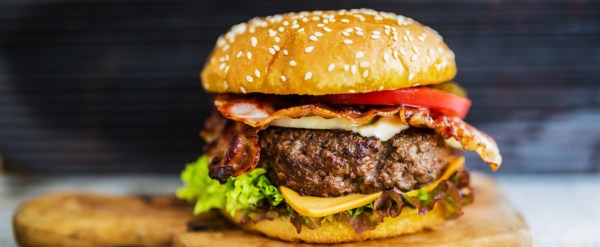
You’d think, in an analysis of meat and veggie burgers, that veggie burgers would come out on top. After all, meat is expensive and often gets turned into horrible heart-destroying monstrosities, while vegetables are cheap. Smashing a mush of veggies into a patty, cooking it, and freezing it is probably dead easy… right? But in the latest analysis of burgers, the ones without meat were the undeniable losers.
Clear Labs, who ran the study, tested 258 samples across both the meat and veggie burger realm. The company uses a semi-quantitative method to evaluate the exact contents of foods. It’s a very granular process; if someone, or something, just touches the sample, it’s going to find the DNA. So while it’s gross that Clear Labs found trace amounts of rat DNA and one burger sample with human DNA in it, it only means a rat, or a human, brushed up against your patty, not that you’re enjoying a Demolition Man special.
On the other hand…

The most likely cause is hair, skin, or fingernail that was accidentally mixed in during the manufacturing process.
So, yeah, ewwwwwwww. In the relatively good news department: Clear only found potential hygienic problems in 1.6% of the samples they studied. So you can chomp without getting sick — but there are still some surprises to be had. The study found a black bean burger with no black beans, two “vegetarian” burgers which turned out to have beef in them, one sample with rat DNA and one with human DNA. Nearly a quarter of the veggie burgers they tested had some sort of problem.
Not that the beef-eating crowd gets away clean. A consistent problem, especially with fast food burgers, is that the calorie count was inaccurate on nearly half of all burgers tested. That’s to be expected, to some degree, as measuring calorie counts is an inexact science for a number of reasons. But 12 of the 47 cases they found among fast food burgers exceeded the stated number by 100 calories or more, which starts to feel pretty misleading.
The study also found a wide variance between fat and carb counts on the labels, and discrepancies about what was actually in the beef. Most worryingly, different meats kept turning up, with beef and chicken subbing in for more expensive products. This might simply be because there was something else left in the grinder, but that still means the grinder wasn’t spotless before it was used. Both veggie and meat burgers had plenty of missing ingredients, unsurprisingly it was usually the expensive stuff or the stuff that’s hard to portion, like spices.
While this is all entertaining, keep this grain of salt handy: You probably ate these burgers and didn’t get sick. Granted, some of this news isn’t great, and veggie burger manufacturers need to tighten up their cleanliness game, but mostly it’s a reminder that product purity standards can always be improved.
(via Gizmodo)






